|
If there is truly a government conspiracy to hide the truth about the UFO phenomenon from the public, one would expect a paper trail. There should be documents describing the conspirators and their actions, the crashed spacecraft, the occupants, and the process of reverse-engineering the remains. The documents would have the highest possible levels of classification, viewable only by a select few. Do such documents exist? And is it possible that some of them have already seen the light of day?
The Majestic Twelve Documents
Since the early 1980s, a large number of purported government documents have been provided by various sources. The documents describe a secret organization called "Operation Majestic Twelve," led by a committee of twelve men, and assigned the task of recovering crashed UFOs and studying them in complete secrecy.
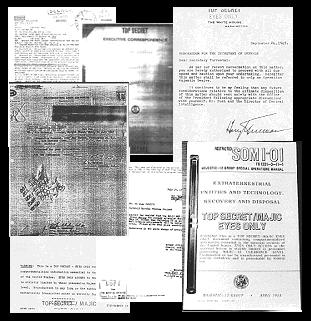 The first alleged documentary reference to Majestic Twelve surfaced in 1981, when UFO investigator William Moore obtained a one-page document regarding UFO photographs from Sergeant Richard Doty of the Air Force Office of Special Investigations. The document, now known as the "Aquarius Teletype," appears to be a retyped telegram containing a reference to "MJ TWELVE." About two years later, in 1983, Moore received instructions by telephone from an unknown caller, telling him to travel to New York to retrieve some information. At the specified time, a courier arrived at the door of Moore's hotel room, carrying a sealed manila envelope. Moore was given 19 minutes to do whatever he wanted with the contents of the envelope. He photographed the 11-page document contained in the envelope and carefully read the text into a tape recorder. This "Aquarius Briefing Document" referred to "MJ12" and described various UFO crashes, contacts with extraterrestrials, and related government projects. After the 19 minutes had expired, Moore returned the materials to the courier, who checked them before departing.
The first alleged documentary reference to Majestic Twelve surfaced in 1981, when UFO investigator William Moore obtained a one-page document regarding UFO photographs from Sergeant Richard Doty of the Air Force Office of Special Investigations. The document, now known as the "Aquarius Teletype," appears to be a retyped telegram containing a reference to "MJ TWELVE." About two years later, in 1983, Moore received instructions by telephone from an unknown caller, telling him to travel to New York to retrieve some information. At the specified time, a courier arrived at the door of Moore's hotel room, carrying a sealed manila envelope. Moore was given 19 minutes to do whatever he wanted with the contents of the envelope. He photographed the 11-page document contained in the envelope and carefully read the text into a tape recorder. This "Aquarius Briefing Document" referred to "MJ12" and described various UFO crashes, contacts with extraterrestrials, and related government projects. After the 19 minutes had expired, Moore returned the materials to the courier, who checked them before departing.
In December of 1984, Moore's partner, televsion producer Jaime Shandera, received an envelope containing a roll of 35 mm film from somewhere in Albaquerque, New Mexico. On the film were two sets of photographs of the eight-page document now known as the "Eisenhower Briefing Document" because it purports to be a briefing compiled in 1952 for President-elect Dwight D. Eisenhower. The documents lists the 12 members of Operation Majestic Twelve's leadership and summarizes the Kenneth Arnold sighting, the Roswell crash, and the recovery of alien bodies and UFO wreckage. A memo from President Harry Truman to Secretary of Defense James Forrestal authorizing the creation of Operation Majestic Twelve was included as an appendix. Moore and Shandera released these two documents separately in 1987. In 1985, Moore and Shandera found a document referred to as the "Cutler-Twining Memo" in the United States National Archives. The subject of the memo was the "NSC/MJ-12 Special Studies Project." This document was also released by Moore and Shandera in 1987.
Several years later, in 1994, UFOlogist Don Berliner received another roll of 35 mm film, mailed from La Crosse, Wisconsin. Berliner developed the film and found that it contained 32 pages of an alleged Majestic Twelve field manual called "SOM 1-01: Extraterrestrial Entities and Technology, Recovery and Disposal." The manual describes extraterrestrials and their spacecraft and gives instructions for secretly recovering and shipping the wreckage of crashed UFOs.
 In 1996, at the recommendation of UFOlogist Stanton Friedman, UFO researcher and retired aerospace engineer Dr. Robert Wood met Timothy Cooper, who had reported the arrival of a large quantity of UFO-related materials in his mailbox. In all, Cooper has received hundreds of pages of Majestic Twelve documents since 1992. Cooper's sources include an American Legionnaire; a CIA archivist; a retired intelligence employee named Thomas Cantwheel and his daughter, Salina; and three anonymous sources designated "S-1," "S-2," and "S-3."
In 1996, at the recommendation of UFOlogist Stanton Friedman, UFO researcher and retired aerospace engineer Dr. Robert Wood met Timothy Cooper, who had reported the arrival of a large quantity of UFO-related materials in his mailbox. In all, Cooper has received hundreds of pages of Majestic Twelve documents since 1992. Cooper's sources include an American Legionnaire; a CIA archivist; a retired intelligence employee named Thomas Cantwheel and his daughter, Salina; and three anonymous sources designated "S-1," "S-2," and "S-3."
Evaluating the Documents
Ever since the documents first appeared, UFO investigators and questioned document examiners have studied the Majestic Twelve documents in hopes of determining whether or not they are authentic. After studying the documents, several researchers have concluded that they are genuine. Others have drawn the opposite conclusion.
Dr. Wood, now the foremost expert on the Majestic documents, has uncovered a great deal of circumstantial evidence suggesting that the Majestic Twelve documents are indeed authentic. These evidences, while not proving conclusively that the documents are genuine, are at least enough to indicate that the they would have been very difficult to hoax.
 For example, typography analyst James Black showed that the memo from Truman to Forrestal was found to have been typed on a 1940 Underwood Standard typewriter. The field manual, SOM 1-01, contains authentic 1950s language, such as the use of the words "screw driver" rather than the single word "screwdriver" used today, and the acronym "UFOB" instead of the more modern "UFO." The manual's section headings were printed in a 1950s font called Square Gothic. Also, in several places in SOM 1-01, the letter "z" is slightly raised relative to the other letters. An archival specialist noted this as an indicator that the manual was printed on a 1950s hot lead monotype press, instead of a computer which would have been used by a modern-day hoaxer. A witness has even testified to shredding the document, along with the Eisenhower Briefing Document, while working in an admiral's office.
For example, typography analyst James Black showed that the memo from Truman to Forrestal was found to have been typed on a 1940 Underwood Standard typewriter. The field manual, SOM 1-01, contains authentic 1950s language, such as the use of the words "screw driver" rather than the single word "screwdriver" used today, and the acronym "UFOB" instead of the more modern "UFO." The manual's section headings were printed in a 1950s font called Square Gothic. Also, in several places in SOM 1-01, the letter "z" is slightly raised relative to the other letters. An archival specialist noted this as an indicator that the manual was printed on a 1950s hot lead monotype press, instead of a computer which would have been used by a modern-day hoaxer. A witness has even testified to shredding the document, along with the Eisenhower Briefing Document, while working in an admiral's office.
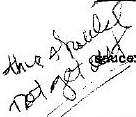 Many of the documents provided by Cooper were typed on authentic 8 x 10 1/2 in. paper, used in the 1940s, instead of the modern 8 1/2 x 11 in. paper used today. Some of them also appear to have been typed on the thin "onion skin" paper often used at the time. A watermark on one of the documents was traced to a company that went out of business by the 1960s. Handwritten notes on a manuscript, seen to the left, were tested and found to have been made by a pencil manufactured in the 1950s. An essay attributed to Professor Albert Einstein seems to have been written in Einstein's style, suggesting that Einstein was indeed the author. A memo attributed to President John F. Kennedy was probably typed on a Remington typewriter; Kennedy's secretary is known to have used a Remington.
Many of the documents provided by Cooper were typed on authentic 8 x 10 1/2 in. paper, used in the 1940s, instead of the modern 8 1/2 x 11 in. paper used today. Some of them also appear to have been typed on the thin "onion skin" paper often used at the time. A watermark on one of the documents was traced to a company that went out of business by the 1960s. Handwritten notes on a manuscript, seen to the left, were tested and found to have been made by a pencil manufactured in the 1950s. An essay attributed to Professor Albert Einstein seems to have been written in Einstein's style, suggesting that Einstein was indeed the author. A memo attributed to President John F. Kennedy was probably typed on a Remington typewriter; Kennedy's secretary is known to have used a Remington.
All of these evidences point strongly to the conclusion that the Majestic documents are genuine, authored by the people they are claimed to have been written by, and produced during the time period they were alleged to have been created in. However, some still dispute this conclusion, asserting that the documents were forged by a modern-day hoaxer. Most of their arguments have already been satisfactorily refuted by Dr. Wood; interested readers are directed to Wood's papers for the details of these arguments. Some critics, though, have raised concerns that Wood has not yet been able to address. The most vocal of these critics was journalist and author Philip J. Klass.
Blight Investigations Exclusive: Klass Dismissed
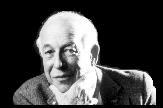 For over a decade, Philip Klass, hailed by his supporters as the "Sherlock Holmes of UFOlogy," was the sole writer and editor for "The Skeptics UFO Newsletter," a now-discontinued bi-monthly newletter that sought to discredit UFO cases, UFO eyewitnesses, and UFO investigators. It is in this newsletter that Klass published his criticisms of the Majestic documents.
For over a decade, Philip Klass, hailed by his supporters as the "Sherlock Holmes of UFOlogy," was the sole writer and editor for "The Skeptics UFO Newsletter," a now-discontinued bi-monthly newletter that sought to discredit UFO cases, UFO eyewitnesses, and UFO investigators. It is in this newsletter that Klass published his criticisms of the Majestic documents.
One of Klass' earliest complaints was that the alleged author of the Eisenhower Briefing Document, Rear Admiral Roscoe H. Hillenkoetter, was named in the document as "Adm. Roscoe H. Hillenkoetter," rather than "R. H. Hillenkoetter," the way Hillenkoetter gave his name in business letters. These criticisms do not stand up under scrutiny. The Eisenhower Briefing Document was clearly not a business letter.
 One of the obvious purposes of the document was to indentify the 12 members of the Majestic Twelve committee for Eisenhower. Thus it would have been appropriate for Hillenkoetter to have given his full name on this occasion. Klass also argues that Hillenkoetter's rank is given incorrectly; he is named as an admiral rather than as a rear admiral, as shown to the right. However, it is fairly common for two- and three-star admirals and generals to be referred to simply as "admiral" or "general." For example, in an authentic letter, from Colonel Donald Zimmerman to Lieutenant General Nathan Twining, written on September 12, 1947, and now kept at the National Archives, Zimmerman refers to Twining as "General Twining," as seen to the right.
One of the obvious purposes of the document was to indentify the 12 members of the Majestic Twelve committee for Eisenhower. Thus it would have been appropriate for Hillenkoetter to have given his full name on this occasion. Klass also argues that Hillenkoetter's rank is given incorrectly; he is named as an admiral rather than as a rear admiral, as shown to the right. However, it is fairly common for two- and three-star admirals and generals to be referred to simply as "admiral" or "general." For example, in an authentic letter, from Colonel Donald Zimmerman to Lieutenant General Nathan Twining, written on September 12, 1947, and now kept at the National Archives, Zimmerman refers to Twining as "General Twining," as seen to the right.
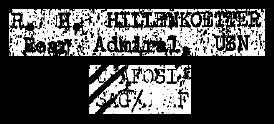 Another of Klass' criticisms centers on a purported memo from Hillenkoetter to President Truman in which Hillenkoetter offers to send "Black Book" summaries of significant top secret UFO reports to the President. Klass noted that the document names the U.S. Air Force Office of Special Investigations as one of the recipients of a carbon copy of the memo. Klass argued that, since the memo was typed in February of 1948, and the Office was not established until August 1, 1948, the memo must be a hoax. Klass, however, failed to note that the carbon copy distribution list is much lighter than the rest of the memo, as seen to the left, indicating that it was in fact added at a later date, after the typewriter's ribbon had seen considerable use.
Another of Klass' criticisms centers on a purported memo from Hillenkoetter to President Truman in which Hillenkoetter offers to send "Black Book" summaries of significant top secret UFO reports to the President. Klass noted that the document names the U.S. Air Force Office of Special Investigations as one of the recipients of a carbon copy of the memo. Klass argued that, since the memo was typed in February of 1948, and the Office was not established until August 1, 1948, the memo must be a hoax. Klass, however, failed to note that the carbon copy distribution list is much lighter than the rest of the memo, as seen to the left, indicating that it was in fact added at a later date, after the typewriter's ribbon had seen considerable use.
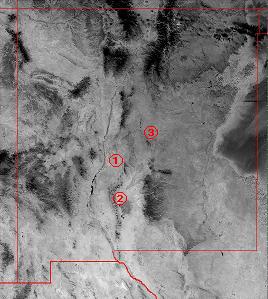 Klass also claimed that there is a contradiction in the documents regarding the number of alien bodies that were recovered from the Roswell crash. According to Klass, the Eisenhower briefing document states that four bodies were found, while two of Cooper's documents allege that five bodies were recovered. A careful reading of the documents in question, paying special attention to the dates given for the recoveries, reveals that there is no contradiction at all. They indicate that there were actually three UFO retrieval operations associated with the Roswell crash: the first at Socorro, New Mexico, the second at White Sands Proving Ground, and the third at Corona, New Mexico. The four alien bodies mentioned in the Eisenhower Briefing Document were recovered at Corona, while the other five had been recovered at Socorro a few days earlier. There is no indication in the documents that any bodies were found at the White Sands crash site.
Klass also claimed that there is a contradiction in the documents regarding the number of alien bodies that were recovered from the Roswell crash. According to Klass, the Eisenhower briefing document states that four bodies were found, while two of Cooper's documents allege that five bodies were recovered. A careful reading of the documents in question, paying special attention to the dates given for the recoveries, reveals that there is no contradiction at all. They indicate that there were actually three UFO retrieval operations associated with the Roswell crash: the first at Socorro, New Mexico, the second at White Sands Proving Ground, and the third at Corona, New Mexico. The four alien bodies mentioned in the Eisenhower Briefing Document were recovered at Corona, while the other five had been recovered at Socorro a few days earlier. There is no indication in the documents that any bodies were found at the White Sands crash site.
This oversight led Klass to make similar mistakes, imagining contradictions regarding the number of craft recovered. The Eisenhower Briefing Document claims that an operation was launched to recover a single crashed UFO on July 7, 1947. Another one of the Majestic documents, an alleged report from the Interplanetary Phenomenon Unit, states that more than one object was recovered between July 4 and July 6, 1947. Klass argued that this is a contradiction, but he was again confused. According to the documents, the first two crashed UFOs were retrieved between July 4 and July 6, followed by the operation to recover the final object at Corona on July 7. On this point, then, the documents are fully consistent. Klass also claimed that cattle rancher William Brazel, who discovered the debris at Corona, did not drive to Roswell to report his find until July 7. This claim is false. Brazel reported the wreck to Chavez County sheriff George Wilcox, who then alerted the authorities at Roswell Army Air Force Base, on July 6. Anyway, this point makes no difference, since the documents indicate that only the two other craft were recovered prior to July 7.
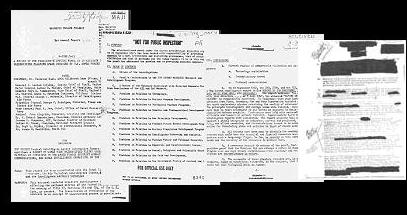 Klass made still more errors while questioning a document alleged to be an annual report on Operation Majestic Twelve. He misidentified it as the first annual report, noted that it contains details on events occuring in 1951, and asked why Majestic Twelve's first annual report would have been issued over three years after the group was established. In reality, the "annual report" is actually a piecemeal document made up of four parts, seen to the left, each received by Cooper on a different date. Cooper received the cover page for the purported First Annual Report in 1994. A table of contents for an annual report was received later that year. It was not until 1995 that Cooper received the body of a Majestic Twelve annual report. An appendix to an annual report arrived later. Of the four fragments Cooper received, only the cover page had the words "1st Annual Report" in it. There is no reason to assume that the other three fragments are also part of the First Annual Report; they likely come from later annual reports. Klass also incorrectly argued that the First Annnual Report cover page states that Majestic Twelve was run by Dr. Vannevar Bush, contradicting the Eisenhowever Briefing Document, which names Hillenkoetter as the head. In the same vein, Klass argued that the cover page indicates that there were 14 members of the Majestic Twelve committee, rather than the 12 named in the Eisenhower Briefing Document. Klass was wrong on both counts. The cover page lists the alleged members of the "President's special panel" on Majestic Twelve, not the leadership committee of Majestic Twelve. Likewise, Dr. Bush is named as the head of the panel, not as the head of Operation Majestic Twelve.
Klass made still more errors while questioning a document alleged to be an annual report on Operation Majestic Twelve. He misidentified it as the first annual report, noted that it contains details on events occuring in 1951, and asked why Majestic Twelve's first annual report would have been issued over three years after the group was established. In reality, the "annual report" is actually a piecemeal document made up of four parts, seen to the left, each received by Cooper on a different date. Cooper received the cover page for the purported First Annual Report in 1994. A table of contents for an annual report was received later that year. It was not until 1995 that Cooper received the body of a Majestic Twelve annual report. An appendix to an annual report arrived later. Of the four fragments Cooper received, only the cover page had the words "1st Annual Report" in it. There is no reason to assume that the other three fragments are also part of the First Annual Report; they likely come from later annual reports. Klass also incorrectly argued that the First Annnual Report cover page states that Majestic Twelve was run by Dr. Vannevar Bush, contradicting the Eisenhowever Briefing Document, which names Hillenkoetter as the head. In the same vein, Klass argued that the cover page indicates that there were 14 members of the Majestic Twelve committee, rather than the 12 named in the Eisenhower Briefing Document. Klass was wrong on both counts. The cover page lists the alleged members of the "President's special panel" on Majestic Twelve, not the leadership committee of Majestic Twelve. Likewise, Dr. Bush is named as the head of the panel, not as the head of Operation Majestic Twelve.
 The purported Operation Majestic Twelve field manual, SOM 1-01, suggests a number of prosaic explanations for UFO sightings and crashes that might be used by agents to deceive the public. One of the explanations listed were downed satellites. Klass argued that, since SOM 1-01 was supposedly printed in 1954, three years before the first satellite launch, the document must be a hoax. However, Dr. Wood pointed out that the United States' plans to experiment with satellites were well-known by 1954. Klass countered by claiming that no such plans had been made or revealed at that time. In response, Dr. Wood gave several references from popular literature published in 1953 and early 1954 that discuss satellite technology. In addition, Blight Investigations has learned that, in 1948, Secretary Forrestal's annual report, a known authentic document not related to Majestic Twelve, revealed that a United States Committee on Guided Missiles had recommended that the armed forces focus their efforts on studies and component designs for satellites. A Russian newspaper even called this plan "madman Forrestal's idea of an Earth satellite." Also, in early 1954, Alexander Nesmeyanov, president of the Soviet Academy of Sciences, stated that Soviet space technology had progressed to the point where the U.S.S.R. was capable of putting a satellite in orbit. Klass was wrong--again.
The purported Operation Majestic Twelve field manual, SOM 1-01, suggests a number of prosaic explanations for UFO sightings and crashes that might be used by agents to deceive the public. One of the explanations listed were downed satellites. Klass argued that, since SOM 1-01 was supposedly printed in 1954, three years before the first satellite launch, the document must be a hoax. However, Dr. Wood pointed out that the United States' plans to experiment with satellites were well-known by 1954. Klass countered by claiming that no such plans had been made or revealed at that time. In response, Dr. Wood gave several references from popular literature published in 1953 and early 1954 that discuss satellite technology. In addition, Blight Investigations has learned that, in 1948, Secretary Forrestal's annual report, a known authentic document not related to Majestic Twelve, revealed that a United States Committee on Guided Missiles had recommended that the armed forces focus their efforts on studies and component designs for satellites. A Russian newspaper even called this plan "madman Forrestal's idea of an Earth satellite." Also, in early 1954, Alexander Nesmeyanov, president of the Soviet Academy of Sciences, stated that Soviet space technology had progressed to the point where the U.S.S.R. was capable of putting a satellite in orbit. Klass was wrong--again.
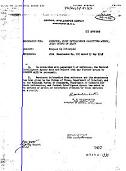 In 1999, when a Freedom of Information Act request from Timothy Cooper resulted in a release by the U.S. government of a document naming "MJ-12" in its file distribution listing, Dr. Wood asserted that the document constituted undisputable proof of the existence of Operation Majestic Twelve, and confirmation of the authenticity of the Majestic documents. The document appears to be an April 12, 1949, memo from Hillenkoetter to the director of the Joint Intelligence Objectives Agency and the Joint Chiefs of Staff. It was released by the CIA in 1985. Klass nonetheless claimed that the document is a hoax. He noted that the left margin of the file distribution listing is slightly smaller than the left margin of the rest of the memo, and argued that this indicates that the the file distribution was added to an otherwise authentic memo by a hoaxer long after it was typed. However, even a cursory examination of the document in question reveals that Klass was in error. The left margin of the file distribution is smaller than the left margin of the rest of the memo because the entire memo is slanted slightly in a clockwise direction, as shown by the blue line in the image to the left.
In 1999, when a Freedom of Information Act request from Timothy Cooper resulted in a release by the U.S. government of a document naming "MJ-12" in its file distribution listing, Dr. Wood asserted that the document constituted undisputable proof of the existence of Operation Majestic Twelve, and confirmation of the authenticity of the Majestic documents. The document appears to be an April 12, 1949, memo from Hillenkoetter to the director of the Joint Intelligence Objectives Agency and the Joint Chiefs of Staff. It was released by the CIA in 1985. Klass nonetheless claimed that the document is a hoax. He noted that the left margin of the file distribution listing is slightly smaller than the left margin of the rest of the memo, and argued that this indicates that the the file distribution was added to an otherwise authentic memo by a hoaxer long after it was typed. However, even a cursory examination of the document in question reveals that Klass was in error. The left margin of the file distribution is smaller than the left margin of the rest of the memo because the entire memo is slanted slightly in a clockwise direction, as shown by the blue line in the image to the left.
 Klass also argued that some of the Majestic documents, allegedly typed by many different individuals on many different typewriters, were actually typed on the same typewriter. If a typewriter is not cleaned frequently enough, its ink ribbon will deposit "crud" on the typeface, causing the circular parts of small, frequently used letters to be filled in every time they are used. Klass claimed that Twining's 1947 "White Hot" report and the circa-1952 Annual Report both contain crud in the letters "d," "e," "o," and "p," indicating that they were actually typed on the same typewriter by a hoaxer. Klass' claim was false: in most instances, these letters are not filled in with crud, as seen to the right. Klass also claimed that a document purporting to be a July 1947 field order to the "Interplanetary Phenomenon Unit" and a June 1947 essay allegedly written by Prof. Albert Einstein and Dr. J. Robert Oppenheimer both contain crud in the letter "p." This, too, is false. Because these letters are sometimes filled in and sometimes not, a different explanation presents itself. When a document is reproduced with a copy machine, overexposure can sometimes cause a few letters to be filled in. Hence the documents in question were not typed on the same typewriter.
Klass also argued that some of the Majestic documents, allegedly typed by many different individuals on many different typewriters, were actually typed on the same typewriter. If a typewriter is not cleaned frequently enough, its ink ribbon will deposit "crud" on the typeface, causing the circular parts of small, frequently used letters to be filled in every time they are used. Klass claimed that Twining's 1947 "White Hot" report and the circa-1952 Annual Report both contain crud in the letters "d," "e," "o," and "p," indicating that they were actually typed on the same typewriter by a hoaxer. Klass' claim was false: in most instances, these letters are not filled in with crud, as seen to the right. Klass also claimed that a document purporting to be a July 1947 field order to the "Interplanetary Phenomenon Unit" and a June 1947 essay allegedly written by Prof. Albert Einstein and Dr. J. Robert Oppenheimer both contain crud in the letter "p." This, too, is false. Because these letters are sometimes filled in and sometimes not, a different explanation presents itself. When a document is reproduced with a copy machine, overexposure can sometimes cause a few letters to be filled in. Hence the documents in question were not typed on the same typewriter.
 Finally, Klass attempted to connect the Majestic documents to two letters from Timothy Cooper to British UFOlogist Timothy Good, arguing that Cooper typed them all. Klass observed that the letters "G" and "N," and the number "8," are slightly elevated relative to the rest of the text in both of Cooper's letters and in the Annual Report. He accused Cooper of using the same typewriter he used in his letters to hoax the Annual Report. However, Klass ignored the differences between the appearance of the number "0" in Cooper's letters and in the Annual Report. In Cooper's letters, the number "0" is large, as tall as the number "2" that accompanies it in Good's address. In the Annual Report, the number "0" is slightly smaller, and not as tall as the number "2" that appears next to it in the sentence "Approximately 1,200 memoranda..." Examples of both are shown to the left. They were not typed on the same typewriter. Klass' accusation was false.
Finally, Klass attempted to connect the Majestic documents to two letters from Timothy Cooper to British UFOlogist Timothy Good, arguing that Cooper typed them all. Klass observed that the letters "G" and "N," and the number "8," are slightly elevated relative to the rest of the text in both of Cooper's letters and in the Annual Report. He accused Cooper of using the same typewriter he used in his letters to hoax the Annual Report. However, Klass ignored the differences between the appearance of the number "0" in Cooper's letters and in the Annual Report. In Cooper's letters, the number "0" is large, as tall as the number "2" that accompanies it in Good's address. In the Annual Report, the number "0" is slightly smaller, and not as tall as the number "2" that appears next to it in the sentence "Approximately 1,200 memoranda..." Examples of both are shown to the left. They were not typed on the same typewriter. Klass' accusation was false.
When all is said and done, answering Klass' criticisms still cannot prove that the Majestic documents are authentic, or that Operation Majestic Twelve does exist or ever did exist. It does, however, remove the only remaining source of doubt that the documents are genuine. It also demonstrates the incompetence, dishonesty, and overall sloppiness of the work done by UFO "debunkers" like Philip Klass. Proper investigation requires evidence before a conclusion is drawn. At this point, the claim that the Majestic documents are a hoax is the one without evidence, while numerous pieces of evidence continue to support the authenticity of the documents.
|